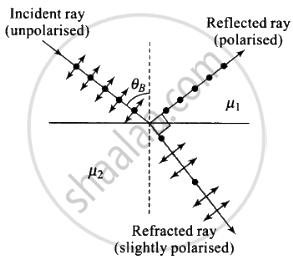Advertisements
Advertisements
Question
Can reflection result in plane polarised light if the light is incident on the interface from the side with higher refractive index?
Solution
If angle of incidence is equal to Brewster’s angle, the transmitted light is slightly polarised and reflected light is plane polarised.

Polarisation by reflection occurs when the angle of incidence is Brewster's angle.
i.e., `tan i_B = ""^1mu_2 = mu_2/mu_1` where `mu_2 < mu_1`
When the light rays travel in such a medium, the critical angle is
`sin i_C = mu_2/mu_1`, where `mu_2 < mu_1`
As `|tan i_B| > |sin i_C|` for large angles `i_B < i_C`
Thus, the polarisation by reflection occurs definitely.
Important point: Brewster's angle (also known as the polarization angle) is an angle of incidence at which light with a particular polarization is perfectly transmitted through a transparent dielectric surface, with no reflection. When unpolarized light is incident at this angle, the light that is reflected from the surface is therefore perfectly polarized. This special angle of incidence is named after the Scottish physicist Sir David Brewster.
APPEARS IN
RELATED QUESTIONS
Find an expression for intensity of transmitted light when a polaroid sheet is rotated between two crossed polaroids. In which position of the polaroid sheet will the transmitted intensity be maximum?
Two polaroids P1 and P2 are placed with their pass axes perpendicular to each other. An unpolarised light of intensity I0 is incident on P1. A third polaroid P3 is kept in between P1 and P2 such that its pass axis makes an angle of 30° with that of P1. Determine the intensity of light transmitted through P1, P2 and P3
What is the value of refractive index of a medium of polarising angle 60°?
What is the difference between polarised light and unpolarised light?
What is polarisation?
Discuss about Nicol prism.
An unpolarised light of intensity 32 Wm-2 passes through three Polaroids such that the axes of the first and the last Polaroids are at 90°. What is the angle between the axes of the first and middle Polaroids so that the emerging light has an intensity of only 3 Wm-2?
Which of the following phenomena is not common to sound and light waves?
To ensure almost 100 per cent transmissivity, photographic lenses are often coated with a thin layer of dielectric material. The refractive index of this material is intermediated between that of air and glass (which makes the optical element of the lens). A typically used dielectric film is MgF2 (n = 1.38). What should the thickness of the film be so that at the center of the visible spectrum (5500 Å) there is maximum transmission.
An unpolarized light beam is incident on the polarizer of a polarization experiment and the intensity of light beam emerging from the analyzer is measured as 100 Lumens. Now, if the analyzer is rotated around the horizontal axis (direction of light) by 30° in clockwise direction, the intensity of emerging light will be ______ Lumens.
